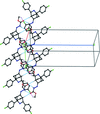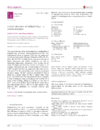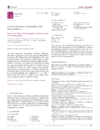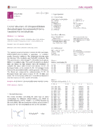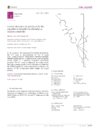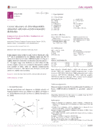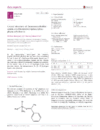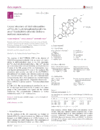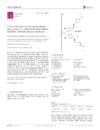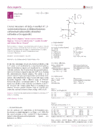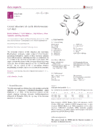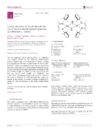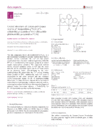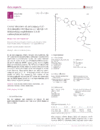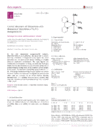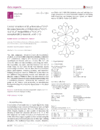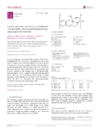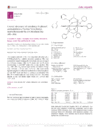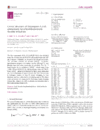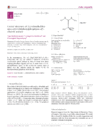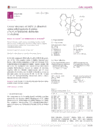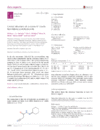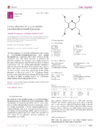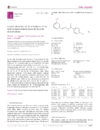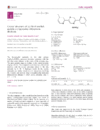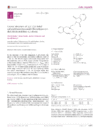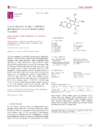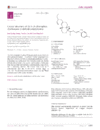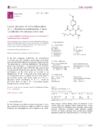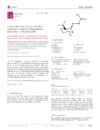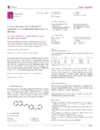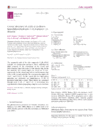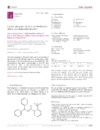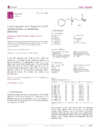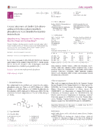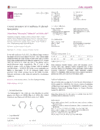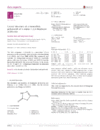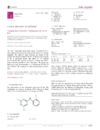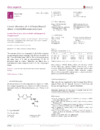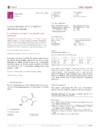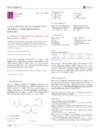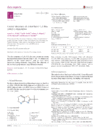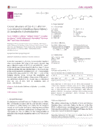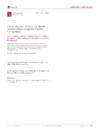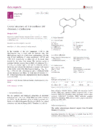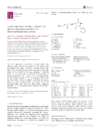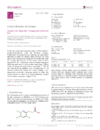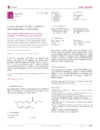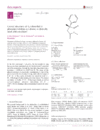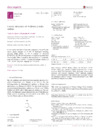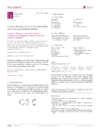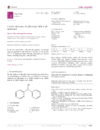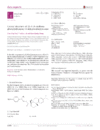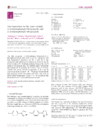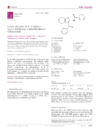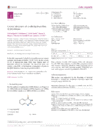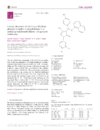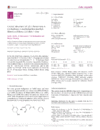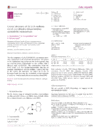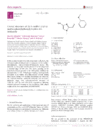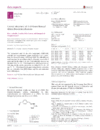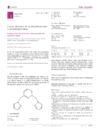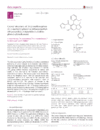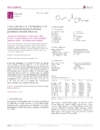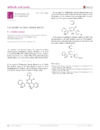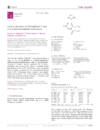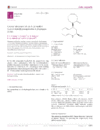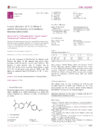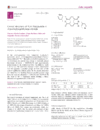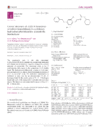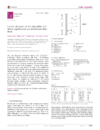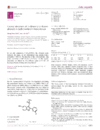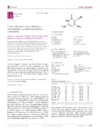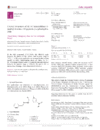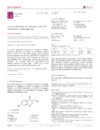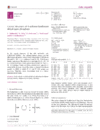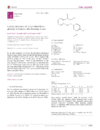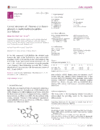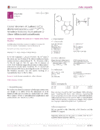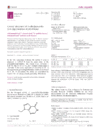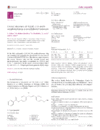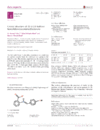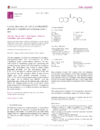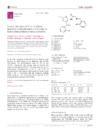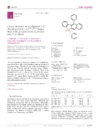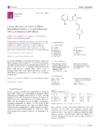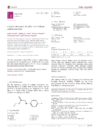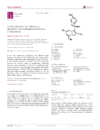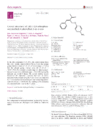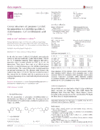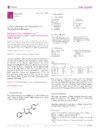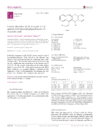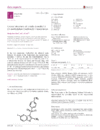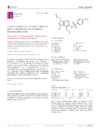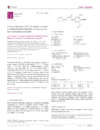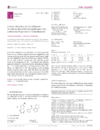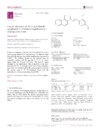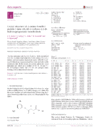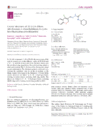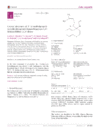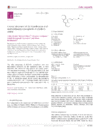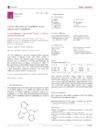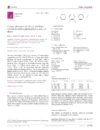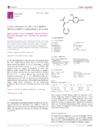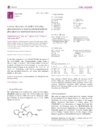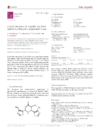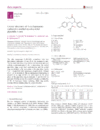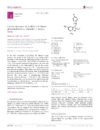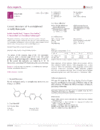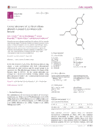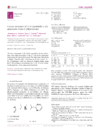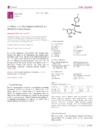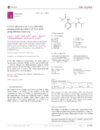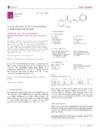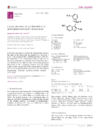issue contents
September 2014 issue

Cover illustration: The molecular structure of 2,7-diethoxy-1,8-bis(4-nitrobenzoyl)naphthalene possesses crystallographically imposed twofold symmetry with two C atoms lying on the rotation axis. The crystal packing is characterized by C-H O=C hydrogen bonds between the benzene rings and the carbonyl groups and C-H
O=C hydrogen bonds between the benzene rings and the carbonyl groups and C-H O=N hydrogen bonds between the benzene rings and the nitro groups. See: Mohri, Ohisa, Noguchi, Yonezawa & Okamoto [Acta Cryst. (2014). E70, 138-141].
O=N hydrogen bonds between the benzene rings and the nitro groups. See: Mohri, Ohisa, Noguchi, Yonezawa & Okamoto [Acta Cryst. (2014). E70, 138-141].
research communications
Download citation


Download citation


The molecular structure of [HgCl2(C12H20N2)] is a rare example where the HgII atom is bound to a Cl2N2 donor set for which the N atoms originate from aliphatic tertiary amine groups.
CCDC reference: 1016995
Download citation


Download citation


The crystal structure of the title compound allowed the cis substituent orientation on the cyclopentanone ring to be established. The molecular conformation and crystal packing are governed by a network of hydrogen bonds and by π–π stacking.
CCDC reference: 1017486
Download citation


Download citation


In the title compound the four-fused-rings system is approximately planar and the pyrrolidine rings of the pyrrolidizine fragment adopt a twist conformation. In the crystal, molecules are linked by C—H⋯O hydrogen bonds and C—H⋯π interactions, forming double-chains parallel to the c axis.
CCDC reference: 1017369
Download citation


Download citation


In the title compound, the pyran and pyrone rings adopt slightly distorted half-chair and envelope conformations, respectively. In the crystal, C—H⋯O and π–π interactions connect the molecules, forming double layers that stack along the c-axis direction.
CCDC reference: 962784
Download citation


Download citation


The structure of a TEMPO derivative with a propynyloxy substituent at the 4-position of the piperidine ring is reported. The crystal packing features an unusual C—H⋯π interaction involving the triple bond of the propyne group which combines with C—H⋯O hydrogen bonds to stack the molecules along the b-axis direction.
CCDC reference: 1017949
Download citation


Download citation


Crystal structure of magnesium selenate heptahydrate, MgSeO4·7H2O, from neutron time-of-flight data
The structure of MgSeO4·7H2O has been determined by single-crystal Laue diffraction methods using pulsed neutron radiation. The compound is isostructural with the sulfate analogue, MgSO4·7H2O.
CCDC reference: 1019812
Download citation


Download citation


The title compound possesses crystallographically imposed twofold symmetry with two C atoms lying on the rotation axis and has a non-coplanarly accumulated aromatic-rings structure. In the crystal, C—H⋯O=C hydrogen bonds between the benzene rings and the carbonyl groups and C—H⋯O=N hydrogen bonds between the benzene rings and the nitro groups are observed; these C—H⋯O hydrogen bonds link the molecules, forming a three-dimensional structure.
CCDC reference: 1019755
Download citation


Download citation


In this CdII complex incorporating two monodentate acetate groups and two N,N′-chelating pyridine-2-carboxamide oxime ligands, molecules are assembled into chains along the c axis via N—H⋯O hydrogen bonding. The resulting chains are further assembled by ethanol solvent molecules into a three-dimensional supermolecular structure.
CCDC reference: 1017896
Download citation


Download citation


In the title compound, the bicyclic ring system adopts a twin-chair conformation. In the crystal, N—H⋯O, C—H⋯O and C—H⋯F interactions connect the molecules, forming supramolecular chains propagating along the b-axis direction.
CCDC reference: 1020373
Download citation


Download citation


Chromium(III) complexes of two ethylene cross-bridged tetraazamacrocycles were prepared and structurally characterized in order to extend the coordination chemistry of this ligand type farther towards the early transition metals.
Download citation


Download citation


In the title compound, the 1,2,3,4-tetrahydropyridine ring of the quinoline moiety adopts a half-chair conformation while the pyrrolidine ring has an envelope conformation. In the crystal, molecules are linked by N—H⋯O and C—H⋯O hydrogen bonds, forming sheets lying parallel to (10 ), which are linked via C—H⋯F hydrogen bonds and C—H⋯π interactions, forming a three-dimensional structure.
), which are linked via C—H⋯F hydrogen bonds and C—H⋯π interactions, forming a three-dimensional structure.
CCDC reference: 1021159
Download citation


Download citation


A distinctive feature of the crystal structure is the geometry of the dtba moiety, which appears to be stretched and acts as an hydrogen-bonding connector, forming linear chains along [-211] with the 4,4′-bpy moiety by way of O—H⋯N hydrogen bonds and C—H⋯O interactions. The influence of the molecular shape on the hydrogen-bonding pattern is analysed by comparing the title compound and two other 4,4′-bpy co-crystals, showing the way in which this correlates with the packing arrangement.
CCDC reference: 1019479
data reports
inorganic compounds
Download citation


Download citation


Download citation


Download citation


Download citation


Download citation


Download citation


Download citation


metal-organic compounds
Download citation


Download citation


Download citation


Download citation


Download citation


Download citation


Download citation


Download citation


Download citation


Download citation


Download citation


Download citation


Download citation


Download citation


Download citation


Download citation


Download citation


Download citation


Download citation


Download citation


Download citation


Download citation


Download citation


Download citation


Download citation


Download citation


Download citation


Download citation


Download citation


Download citation


Download citation


Download citation


Download citation


Download citation


Download citation


Download citation


Download citation


Download citation


organic compounds
Download citation


Download citation


Download citation


Download citation


Download citation


Download citation


Download citation


Download citation


Download citation


Download citation


Download citation


Download citation


Download citation


Download citation


Download citation


Download citation


Download citation


Download citation


Download citation


Download citation


Download citation


Download citation


Download citation


Download citation


Download citation


Download citation


Download citation


Download citation


Download citation


Download citation


Download citation


Download citation


Download citation


Download citation


Download citation


Download citation


Download citation


Download citation


Download citation


Download citation


Download citation


Download citation


Download citation


Download citation


Download citation


Download citation


Download citation


Download citation


Download citation


Download citation


Download citation


Download citation


Download citation


Download citation


Download citation


Download citation


Download citation


Download citation


Download citation


Download citation


Download citation


Download citation


Download citation


Download citation


Download citation


Download citation


Download citation


Download citation


Download citation


Download citation


Download citation


Download citation


Download citation


Download citation


Download citation


Download citation


Download citation


Download citation


Download citation


Download citation


Download citation


Download citation


Download citation


Download citation


Download citation


Download citation


Download citation


Download citation


Download citation


Download citation


Download citation


Download citation


Download citation


Download citation


Download citation


Download citation


Download citation


Download citation


Download citation


Download citation


Download citation


Download citation


Download citation


Download citation


Download citation


Download citation


Download citation


Download citation


Download citation


Download citation


Download citation


Download citation


Download citation


Download citation


Download citation


Download citation


Download citation


Download citation


Download citation


Download citation


Download citation


Download citation


Download citation


Download citation


Download citation


Download citation


Download citation


Download citation


Download citation


Download citation


Download citation


Download citation


Download citation


Download citation


Download citation


Download citation


Download citation


Download citation


Download citation


Download citation


Download citation


Download citation


Download citation


Download citation


Download citation


Download citation


Download citation


Download citation


Download citation


Download citation


Download citation


Download citation


Download citation


Download citation


Download citation


Download citation


Download citation


Download citation


Download citation


Download citation


Download citation


Download citation


Download citation


Download citation


Download citation


Download citation


Download citation


Download citation


Download citation


Download citation


Download citation


Download citation


Download citation


Download citation


Download citation


Download citation


Download citation


Download citation


Download citation


Download citation


Download citation


Download citation


Download citation


Download citation


Download citation


Download citation


Download citation


Download citation


Download citation


Download citation


Download citation


Download citation


Download citation


Download citation


Download citation


Download citation


Download citation


Download citation


Download citation


Download citation


Download citation


Download citation


Download citation


Download citation


Download citation


Download citation


Download citation


Download citation


Download citation


Download citation


Download citation


Download citation


Download citation


Download citation


Download citation


Download citation


Download citation


Download citation


Download citation


Download citation


Download citation


Download citation


Download citation


Download citation




 journal menu
journal menu



















